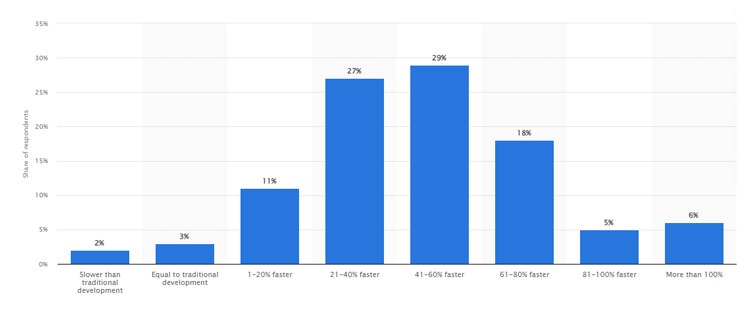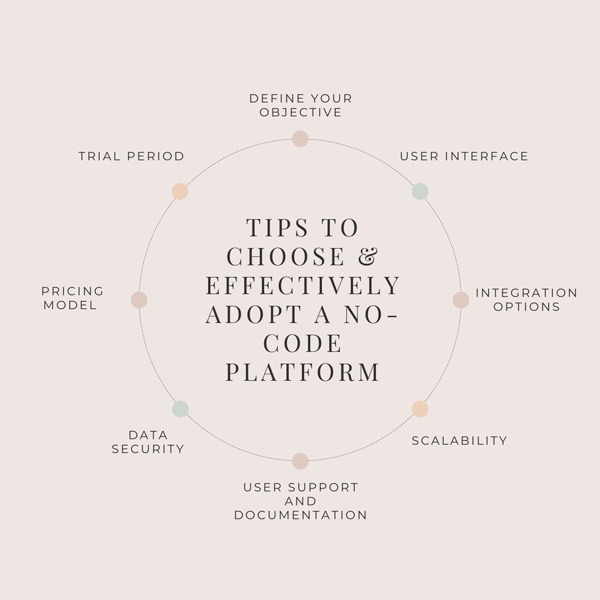The demand for speedy application development has never been greater in an era when digital innovation is the lifeblood of businesses and organizations all around the world. Traditional software development techniques can need significant time, resources, and technical skills, making it difficult for many to keep up with the ever-changing digital world. No-code development platforms (NCDPs) emerge as a game changer in this scenario. Individuals with little to no coding knowledge can build software applications, automate processes, and build digital solutions with astonishing simplicity using no-code development platforms.
As the popularity of no-code platforms grows, the technology sector has seen an increasing number of choices catering to various needs and use cases. As a result, choosing the best no-code development platform for your individual needs can be difficult. This tutorial will take you on an exciting journey through the world of no-code development platforms, throwing light on their capabilities, benefits, and limitations. So, let’s begin on this journey to discover the immense potential of no-code creation and select the ideal platform to unleash your creativity and invention.
What are No-Code Development Platforms?
NCDPs represent a paradigm shift in software development. These platforms are evolving at a rapid pace. As per Statista report the global low-code platform market revenue is estimated to be almost 22.5 billion US dollars in 2022, rising to approximately 32 billion US dollars in 2024. The market is expected to develop at a CAGR of 26.1% during this time period. The graph below depicts the global revenue of low-code development platforms from 2018 to 2025.

Image Source: Statista
No-Code Development Platforms are easy-to-use environments that allow people with varied degrees of technical expertise to build unique software applications without the need for traditional coding abilities. Instead of writing lines of code, users can design, develop, and deploy a wide range of applications, from basic mobile apps to major workflow automation systems, using visual interfaces, drag-and-drop capability, and pre-built templates.
Furthermore, NCDPs enable organizations, entrepreneurs, and professionals to swiftly create, prototype, and improve on software projects, decreasing development time and cost dramatically. They democratize software development, making it more accessible to a wider range of people and hastening the pace of digital transformation across industries.
How Does No-Code Development Platforms Work?
NCDPs (No-Code Development Platforms) are based on the principles of simplicity and abstraction, allowing users to create software applications without writing code. Visual interfaces and simple tools that ease the entire development process are at the core of NCDPs. Users start by designing the structure and functionality of their application by dragging and dropping components, widgets, and forms into place.
To speed up the process, NCDPs frequently provide pre-built templates and design elements. Users can then apply logic and rules to configure the behavior of these components without writing code. Built-in connectors to numerous databases, APIs, and services facilitate data integration. Once the application is complete, NCDPs offer deployment options ranging from web-based apps to mobile apps, all of which are generated automatically.
Advantages of No-Code Development Platforms
No-Code Development Platforms (NCDPs) have numerous benefits that have increased their popularity in the software development sector. Before getting into platform choices, consider the following main benefits of using no-code development tools:
1. Accessibility
Without substantial coding experience, NCDP enables people with diverse levels of technical expertise to develop software applications. They lessen the barriers to engagement and make technology accessible by eliminating complicated code. A wider variety of people, including those with disabilities, are now able to take part in developing digital solutions that cater to their specific requirements thanks to the democratization of app development. No-code platforms encourage a more inclusive and varied tech landscape by having user-friendly interfaces and built-in accessibility capabilities. This benefits both those who make and use digital products.
2. Rapid Development
Coding-free development significantly speeds up the development process. NCDP accelerates application development by abstracting the challenges of traditional coding. According to 29% of respondents in a global poll done in 2021, low-code development is 40-60% faster than conventional development. The graph below shows how much faster low-code development is than traditional development.

Image Source: Statista
Users can swiftly create and roll out software applications with a visual and intuitive interface, frequently in a fraction of the time it takes using conventional coding techniques. This speed enables quick modifications and upgrades, keeping software solutions in line with changing company needs while simultaneously reducing time-to-market. No-code platforms are an important tool for agile development and innovation because they help businesses respond quickly to shifting consumer needs and maintain their competitiveness in an increasingly hectic digital environment.
3. Cost-Efficiency
Hiring developers or outsourcing projects can be more expensive than no-code development. You may deploy resources more efficiently and lessen your dependency on cost-effective development teams by allowing anyone with varied levels of technical competence to create applications. Furthermore, no-code platforms’ rapid development and deployment capabilities result in shorter time-to-market, allowing organizations to achieve returns on their investments sooner. This low-cost strategy democratizes software development, making it available to small firms and startups with limited funds, as well as larger enterprises wishing to streamline their development processes.
4. Flexibility
No-code development platforms enable users to build and adapt software solutions to match their specific business demands. Users can easily adjust and modify applications as their needs evolve without having to rewrite complex code without breaking the boundaries of traditional coding. This adaptability enables rapid iterations, timely updates, and the capacity to respond quickly to changing market circumstances. No-code platforms enable organizations to remain nimble and adjust their software to perfectly match their developing demands, thereby increasing their competitiveness and flexibility in a fast-paced digital landscape.
5. Iterative Development
Users can swiftly prototype, test, and improve their software solutions with NCDP’s highly iterative approach to application development. Coding complexities are abstracted, enabling simple tweaks and alterations that promote quick experimentation and advancement. This iterative process ensures that the end result accurately reflects user wants and business objectives while simultaneously reducing the development time. With the help of no-code platforms, teams may more easily adopt an agile mindset, making it simpler for them to respond to user feedback, change their software offerings in response to changing requirements, and improve their software offerings over time for better efficiency and customer satisfaction.
6. Reduced Maintenance
One significant benefit of no-code development platforms is less maintenance. When compared to typical custom-coded software, NCDP requires less frequent, resource-intensive maintenance. There is less potential for coding errors or problems with more straightforward, visually-driven development procedures, leading to more stable and trustworthy apps. Additionally, no-code platforms frequently offer automated updates and maintenance to keep the program up to speed with changing security standards and technological advancements. By doing this, organizations lighten the stress on their IT personnel and save critical time and resources that allow them to pursue innovative projects and strategic goals rather than ongoing software maintenance.
Tips to Choose Effectively Adopt a No-Code Platform
Choosing and successfully implementing a no-code platform can considerably streamline your development processes and enable non-technical users to design software solutions. Here are the steps to help you make the right choice and maximize your success when adopting a no-code platform:

1. Define Your Objective
Establishing the scope and goals of your project should be your first step. You can choose the most appropriate platform for your needs by having specific goals in mind, such as developing a specific app or optimizing a particular business’s process. It makes sure that the no-code development projects you work on stay on task and adhere to your business’s goals. A well-defined purpose also makes adoption easier because it gives a no-code project a roadmap and directs decisions made during the development phase. By clearly stating your objectives up front, you enhance the possibility that no-code platforms will be fully utilized to boost productivity, efficiency, and creativity inside your company.
2. User Interface
Evaluate the platform’s design capabilities for the user interface. Look for user-friendly drag-and-drop interfaces, adaptable templates, and the ability to build responsive designs for various platforms. A user-friendly and simple design is critical because it allows a broader spectrum of stakeholders, including those with limited technical knowledge, to efficiently use the platform. An intuitive interface shortens the learning curve and enables users to develop, edit, and administer applications without having to grapple with difficult coding principles. To maximize usability and ensure a smooth and productive adoption process, emphasize a no-code platform with a well-designed and accessible user interface when choosing a no-code platform.
3. Integration Options
Check to see if the platform can be integrated with other programs and services that you may need, such as databases, third-party APIs, or payment gateways. For the creation of comprehensive and effective solutions, the ability to easily interface with other tools, systems, and data sources is crucial. It’s critical to evaluate a platform’s compatibility with your current tech stack and the range of integration options it provides, such as API integration, connectors, and support for third-party apps, before choosing it. By bridging data and functionality gaps, your no-code solution can streamline processes and integrate seamlessly with your organization’s current systems. Prioritizing integration capabilities enables you to build complete, integrated solutions that meet your unique business demands while maximizing the platform’s usability.
4. Scalability
Consider the platform’s scalability. At the same time, the primary purpose can be to fulfill specific business requirements. It’s important to plan long-term and look for a platform that allows you to export your code and scale your company’s growth. A scalable no-code platform enables you to grow your applications, meet rising user demand, and react to changing requirements without severe disruptions or the need to transition to a different solution, by evaluating the scalability aspects of a platform and its capacity to handle larger workloads and complexities. You ensure that the money you invest keeps its value and relevance as your company evolves and expands.
5. Data Security
Data security should be the top priority when choosing and properly implementing a no-code platform. As enterprises increasingly rely on NCDP to build and run vital applications, protecting sensitive data becomes critical. It is essential to assess a platform’s security features, which include data encryption, access controls, compliance certifications, and data backup and recovery processes. Look for encryption, authentication, and access control systems. Prioritizing data security not only protects your sensitive information, but also instills trust among users and stakeholders, supporting a seamless and secure adoption process.
6. User Support and Documentation
A strong support system, including responsive customer service, detailed documentation, and a supportive community, can either make or break your adoption process. Adequate documentation ensures that users can quickly learn and understand the platform’s functionality, while easily available support channels help when problems arise. Evaluating the platform’s commitment to user support and the availability of resources such as tutorials, forums, and help centers contributes to a more seamless and efficient adoption experience. It allows you to overcome obstacles, solve issues, and fully utilize the capabilities of the chosen no-code platform for your individual needs.
7. Pricing Model
Understand the platform’s pricing model. It’s critical to understand the pricing structure of the platform, including membership fees, usage-based charges, and any hidden expenditures. Some NCDPs charge based on consumption, whereas others demand a flat monthly cost. Examine whether the cost is in line with your budget and long-term goals. Consider scalability and how price may vary as your platform usage increases. Evaluating the pricing model’s cost-effectiveness and transparency ensures that you can continue your investment and maximize the value of the no-code platform.
8. Trial Period
Take advantage of any free trial periods offered by the platform to test its features and operation. This hands-on experience will help you determine whether the platform meets your requirements. Before making a decision, you may explore the platform’s features, test its capabilities, and assess its suitability for your organization’s needs. During this time, you can assess its usability, integration choices, and general performance, allowing you to make an informed conclusion. A well-structured trial period offers a risk-free opportunity to confirm that the platform corresponds with your goals and workflows.
Low-Code Platforms Use Cases
There are several advantages of using low-code development. Here are some examples of what you can create with low-code and no-code platforms.
1. Mobile Applications
Mobile applications built with low-code platforms offer a versatile solution for a wide range of use cases. These platforms make app creation easier and faster for both individuals and businesses with varied levels of technological experience. No-code platforms enable customers to quickly create and deploy mobile applications tailored to their specific needs, whether they are designing workforce productivity tools, consumer-facing apps, inventory management systems, or educational apps. NCDPs are especially useful to organizations looking to improve operational efficiency, streamline processes, or innovate their engagement with target audiences.
2. Custom Apps
Custom apps created with low-code platforms have a wide range of use cases. Users can use the platform to create bespoke solutions for specific business needs without substantial coding experience. Custom apps can be used to improve internal workflows, automate monotonous operations, improve consumer experiences, and even provide unique data management and analysis tools. They are adaptable tools for businesses of all sizes, from tiny businesses aiming to streamline operations to major enterprises looking to innovate and stay competitive in a quickly changing digital market.
3. Microservices
Microservices architecture, when combined with low-code platforms, provides a flexible and efficient solution for a wide range of use cases. The platform allows developers to break down big programs into smaller, more manageable microservices that can be built, deployed, and scaled independently. This strategy is very useful when developing eCommerce platforms, content management systems, or IoT applications that require rapid development and scaling. Organizations can speed time-to-market, decrease development costs, and readily react to changing business requirements by employing low-code technologies in microservices development.
4. Data Science
Data science, in conjunction with low-code platforms, enables a plethora of practical applications across industries. Low-code platforms make data preparation, analysis, and visualization easier and more accessible to a wider audience. It is possible to use NCDPs to create predictive analytics solutions for financial forecasting, customer behavior analysis, and supply chain optimization. Furthermore, low-code platforms enable rapid development and experimentation in data science, allowing businesses to use the potential of data-driven insights without requiring considerable coding experience.
The Bottom Line
The significance of choosing the best no-code development platform for your unique needs cannot be stressed while going through the evolving environment of such platforms. No-code platforms have entirely altered how businesses develop software solutions, providing incredible accessibility and effectiveness. However, it’s advisable to think about cooperating with expert organizations that provide specialized mobile app development services in order to fully realize their potential. By doing this, you can maximize the return on your no-code platform investment by making use of their knowledge, skills, and experience.




